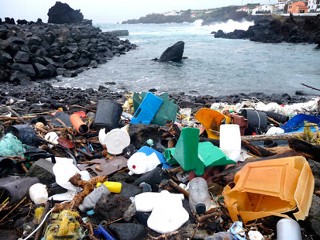 Two separate studies conducted by ocean research groups found that millions of micro-particles of plastic are floating in the waters between Bermuda and Portugal’s mid-Atlantic Azores islands, threatening fish, ocean mammals and, potentially, the sea life humans farm for food.
Two separate studies conducted by ocean research groups found that millions of micro-particles of plastic are floating in the waters between Bermuda and Portugal’s mid-Atlantic Azores islands, threatening fish, ocean mammals and, potentially, the sea life humans farm for food.
The studies describe a soup of micro-particles similar to the so-called Great Pacific Garbage Patch, a phenomenon discovered a decade ago between Hawaii and California that researchers say is likely to exist in other places around the globe.
“I think a lot of people have this idea that there’s a plastic garbage island out there in the sea, and that’s not really what we see out there,” Lead investigator Kara Lavender Law said. “If you’re not looking for anything, you wouldn’t see these plastic particles, but we know that there are clearly millions of them out there.”
“It’s shocking to see it firsthand,” said Anna Cummins, who collected plastic samples on a sailing voyage in February. “Nothing compares to being out there. We’ve managed to leave our footprint really everywhere.”
Long trails of seaweed, mixed with bottles, crates and other flotsam, drift in the still waters of the area, known as the North Atlantic Subtropical Convergence Zone. Cummins’ team even netted a Trigger fish trapped alive inside a plastic bucket.
But the most nettlesome trash is nearly invisible: countless specks of plastic, often smaller than pencil erasers, suspended near the surface of the deep blue Atlantic.
Law said that the pieces of plastic her team picked up in the nets were generally very small—up to 1cm across—with a maximum plastic density of 200,000 pieces of debris per square kilometer . “That’s a maximum that is comparable with the Great Pacific Garbage Patch,” said Law.
“We know that there are ways for plastic to get into the ocean through rivers, sewage, if they’re thrown off the deck of a ship,” Law said. “But when you look at the pieces of plastic, there’s no telling where they’re from. The identifying features are long gone. You can’t look at it and say, ‘This is a Coke bottle from the U.S.'”
Since there is no realistic way of cleaning the oceans, advocates say the key is to keep more plastic out by raising awareness and, wherever possible, challenging a throwaway culture that uses non-biodegradable materials for disposable products.



